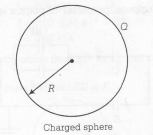Answer:
Option C,D
Explanation:
Potential at the surface of the charged sphere

$V_{0}=\frac{KQ}{R}$
$V=\frac{KQ}{r}$ , $r\geq R$
$= \frac{KQ}{2R^{3}}(3R^{2}-r^{2});r\leq R$
$V_{centre}=V_{c}=\frac{KQ}{2R^{3}}\times3R^{2}$
$\frac{3KQ}{2R}=\frac{3V_{0}}{2}$
$R_{1}=0$
As potential decreases for outside points.
Thus, according to the question, we can write
$V_{R_{2}}=\frac{5V_{0}}{4}=\frac{KQ}{2R^{3}}(3R^{2}-R^{2}_{2})$
$\frac{5V_{0}}{4}=\frac{V_{0}}{2R^{2}}( 3R^{2}-R_{2}^{2})$
or $\frac{5}{2}=3-\left(\frac{R_{2}}{R}\right)^{2}$
$R_{2}=\frac{R}{\sqrt{2}}$
Similarly,
$V_{R_{3}}=\frac{3V_{0}}{4}$
$\Rightarrow$ $\frac{KQ}{R_{3}}=\frac{3}{4}\times\frac{KQ}{R}$
or $R_{3}=\frac{4}{3} R$
$V_{R_{4}}=\frac{KQ}{R_{4}} =\frac{V_{0}}{4}$
$\Rightarrow$ $\frac{KQ}{R_{4}}=\frac{1}{4}\times\frac{KQ}{R}$
OR R4 =4R